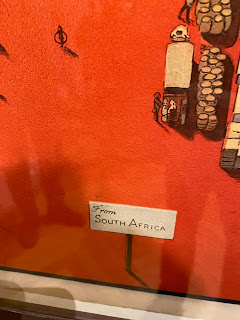Auschwitz Barracks
Auschwitz rail siding where prisoners were sorted
for slave labor or extermination
In March I will be speaking to a group at my synagogue about visiting death camps. More specifically, I will be talking about why I visited eight different death camps between 2017 and last year. Actually nine visits since I went to Auschwitz/Birkenau in both 2017 and 2021.
Auschwitz Gate
It was not my original intention to visit so many death camps. In 2017, I wanted to see the worst death camp, the place where the Holocaust was the worst outside of a death camp, and a place where Jews left and did not return. That year I rode from Belgrade, a place that once had a large Jewish community but now has none, to Auschwitz, the largest death camp, to Lviv, Ukraine, where the Jews were completely wiped out by their neighbors. The Nazis did not have to do anything.
The fence at Birkenau
Until 2017, I had never visited a Holocaust Memorial or a Holocaust Museum or a Death Camp. I lived in Germany from 1976-79, so I certainly had the opportunity, but I grew up in a very non-religious home, so the Holocaust was something that happened that no one I knew talked about.
Then in 2016, Steve Bannon was named Co-Chief-of-Staff in the White House. He owned Brietbart.com, the host of Nazi and fascist web sites.
In early 2017 I planned a trip that would take me to the worst of the Holocaust. After riding from Belgrade to Lviv by way of Auschwitz, I visited the first concentration camp. It was a warehouse in the state of Hesse, Germany, put in service to Hitler in February 1933. It was not a death camp. Anti-Nazi journalists and academics were the first inmates.
Less than a month after I returned from my 2017 trip, Nazis with torches marched in Charlottesville and the President said there were "fine people" on both sides of the protest. He was wrong. Nazis are evil. Nazi sympathizers are evil. I knew I should visit more death camps and be ready to fight Nazis wherever they crawled out from under rocks. Especially now that they had a friend in the American President.
In 2019, just months before the beginning of the COVID epidemic, I was in Germany again. My friend Cliff and I visited the Buchenwald and Dachau death camps.
After visiting four death camps, it became clear that every camp was very different, built where it was for very different reasons and carrying out its mission of murder in its own way.
On my first visit, I was stunned to see the Auschwitz camp was right in the town of Oswiecim, Poland, right near the Catholic Church. The Nazis need a rail junction and barracks to make the biggest death camp. Oswiecim in southern Poland offered both. And the town now lives with the legacy of horror.
Buchenwald was built on a hill above Weimar, where the government was before the Nazis. Hitler built Buchenwald on a hill above Weimar as a raised middle finger to Germans who hated the Nazis. They camp was visible and the smell of death floated down from the camp on the hill.
Dachau, was built early in the Nazi regime. It is first facility built as a concentration camp (Hesse was a converted warehouse) and remained in operation until the end of the war, in part as a "School of Violence." It is right on the edge of the town and, like Buchenwald, not hidden in any way. Dachau is in Bavaria, the most pro-Nazi region of Germany, so the hate was on display.
In 2021 I was vaccinated and returned to Germany. Cliff and I visited the Flossenburg death camp in Bavaria, Auschwitz/Birkenau and Terezin. Later in the same trip, I went to Berlin and visited Sachsenhausen.
Last year on the way to Denmark, Cliff and I visited the Bergen Belsen and Mittlebau-Dora death camps.
Each camp shows another dimension of the Holocaust. I plan to visit more of the camps on future trips to Europe.
I wrote about most of the visits. I will write about the Belsen, Mittlebau-Dora and Sachsenhausen camps by the beginning of March.
My first visit to Auschwitz is here.
The Hesse camp is here.
Buchenwald is here.
Dachau is here.
Preview of the 2021 trip is here.
The 2021 visit to Auschwitz is here.
Flossenburg is here.
Terezin is here.














































